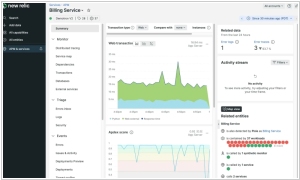New Relic vs StrongLoop
March 19, 2025 | Author: Michael Stromann
20★
New Relic gets you immediate code-level visibility to build faster software, create better products, and delight your customers. New Relic gets you immediate code-level visibility to build faster software, create better products, and delight your customers.
3★
Built on top of the open source LoopBack framework, StrongLoop allows you to visually develop REST APIs in Node and get them connected to your data.
See also:
Top 10 Big Data platforms
Top 10 Big Data platforms
New Relic and StrongLoop, despite their obvious differences, share a peculiar fondness for making developers feel like they’re in control of their applications. Both provide real-time insights, both speak the mystical language of Node.js and both offer APIs that promise to make life easier—though in ways that often result in reading extensive documentation at 3 AM. Oh and they both emerged from the ever-inventive United States, proving once again that if there’s one thing Americans love, it’s building software to monitor other software.
New Relic, which has been lurking around since 2008, is essentially the all-seeing eye of DevOps, an omnipresent force that watches over applications, servers and anything else foolish enough to emit a metric. It caters to large enterprises and IT teams who prefer their existential dread quantified through colorful dashboards. More than just monitoring, it promises full-stack visibility, cloud-native adaptability and even a bit of AI-powered foresight, though it still can't predict why users insist on clicking the one button that breaks everything.
StrongLoop, on the other hand, arrived in 2013 with a very different mission: to help developers craft APIs with the effortless grace of a dolphin navigating the open sea—or at least, that was the dream. Acquired by IBM in 2015, it now lurks within the vast halls of enterprise software, offering the LoopBack framework to anyone brave enough to embrace it. It specializes in API lifecycle management, authentication and making sure your data actually gets to where it’s supposed to go—assuming, of course, you haven’t accidentally fed it malformed JSON.
See also: Top 10 Big Data platforms
New Relic, which has been lurking around since 2008, is essentially the all-seeing eye of DevOps, an omnipresent force that watches over applications, servers and anything else foolish enough to emit a metric. It caters to large enterprises and IT teams who prefer their existential dread quantified through colorful dashboards. More than just monitoring, it promises full-stack visibility, cloud-native adaptability and even a bit of AI-powered foresight, though it still can't predict why users insist on clicking the one button that breaks everything.
StrongLoop, on the other hand, arrived in 2013 with a very different mission: to help developers craft APIs with the effortless grace of a dolphin navigating the open sea—or at least, that was the dream. Acquired by IBM in 2015, it now lurks within the vast halls of enterprise software, offering the LoopBack framework to anyone brave enough to embrace it. It specializes in API lifecycle management, authentication and making sure your data actually gets to where it’s supposed to go—assuming, of course, you haven’t accidentally fed it malformed JSON.
See also: Top 10 Big Data platforms





